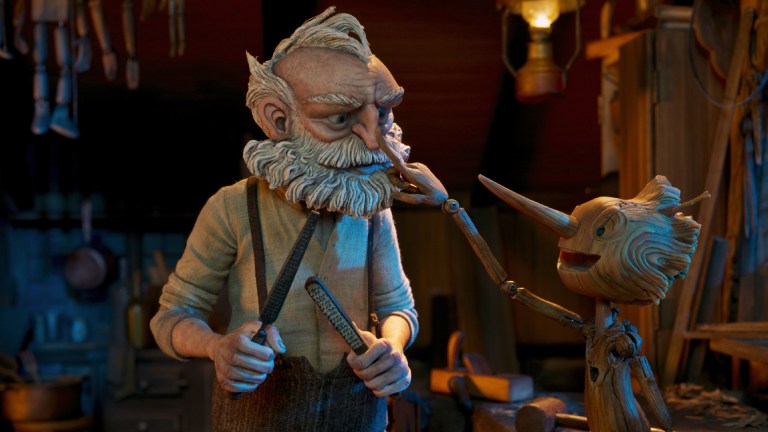Guillermo del Toro’s Pinocchio Will Make You Forget About Disney
Netflix’s new stop-motion version of Pinocchio is a dazzling Guillermo del Toro film through and through.

This is not Uncle Walt’s Pinocchio. The little wooden boy has been a symbol of the Walt Disney Company ever since the original animated classic came out in 1940, and not even an ill-advised live-action remake released by the Mouse House just a few months ago could really sully the original’s reputation. But anyone who watches this new, completely separate stop-motion version of the tale, co-directed by Guillermo del Toro and Mark Gustafson, is in for a dark surprise—and hopefully, some delight.
Del Toro’s Pinocchio is about as different from Disney’s as one could imagine, and not just because this is stop-motion and the latter is traditional animation. For one thing, this is clearly del Toro’s vision, and while it may give perhaps only the littlest viewers a few unpleasant dreams, it is nevertheless infused with the maestro’s Gothic storytelling sensibility (even more so than the 1940 film’s admittedly darker moments).
Guillermo del Toro’s Pinocchio also concerned with many of the same themes that permeate del Toro’s adult-oriented films, including loss, death, memory, the fear of the unknown, and most significantly, the feeling of being an outsider to the world around oneself. That’s exemplified by the director’s take on the wooden protagonist, who’s not the colorful, human-looking puppet of old but an unfinished, skeletal wooden figure with holes for eyes and a spiky, blank-faced head.
That’s what Geppetto comes up with in a drunken, grief-stricken rage one stormy night, sometime after his real son, Carlo, is killed by a bomb that falls on the church in their little Italian town during World War I. Geppetto (voiced by David Bradley) is a woodcarver who uses wood from a tree that grew from a pinecone that Carlo planted to fashion the puppet. A fairy known as a wood sprite (voiced by Tilda Swinton), seeing Geppetto’s pain, gives Pinocchio life in an effort to ease the old man’s grief.
Observing all this is an erudite, somewhat pompous insect named Sebastian J. Cricket (Ewan McGregor), who narrates the story and finds himself inside Pinocchio after Geppetto uses the section of tree that Sebastian inhabits as Pinocchio’s torso. Sebastian is tasked by the wood sprite with acting as the wooden boy’s moral compass and conscience—a task more formidable than one might think.
This Pinocchio (voiced by Gregory Mann, who also handles Carlo in the early scenes) is at first irritating, overly exuberant, impulsive, and wildly self-absorbed. In other words, he’s lot like most little kids. Geppetto is stunned by the fact that his little wood carving has come to life, then tries to shape him into essentially a new Carlo. But Pinocchio has other plans, as does a traveling carnival owner/grifter named Count Volpe (Christoph Waltz), who immediately sees the potential for having a puppet in his show that needs no strings.
Every version of Pinocchio is based ostensibly on Carlo Collodi’s 1883 novel The Adventures of Pinocchio, but del Toro feels no obligation to slavishly stay faithful to the book or the Disney version. Many of the story’s fanciful elements, like the Cat and the Fox, Pinocchio’s excursions to Toyland/Pleasure Island, and his sudden sprouting of donkey ears, don’t appear while the book’s more benign puppet master, Mangiafuoco, is refashioned as the far more malevolent main antagonist, Volpe.
Del Toro (who co-wrote the screenplay with Patrick McHale) also adds the wood sprite’s sister, Death (also voiced by Swinton), whose otherwordly presence helps educate Pinocchio on what it means to be a living being. Del Toro also sets Pinocchio’s adventures against the backdrop of the rise of Mussolini and the advent of World War II.
Placing a supernatural tale about a child’s loss of innocence against the backdrop of war connects Pinocchio to del Toro’s earlier live-action masterpieces, The Devil’s Backbone and Pan’s Labyrinth, but here the lesson is not so much about how these circumstances damage the child but how Pinocchio pushes back against forces which are demanding that the world around him comply to their will.
The idea that a being should be loved for who they are—and not treated as a freak or monster—also provides a direct thematic line to the director’s The Shape of Water and his unmade dream project, Frankenstein (speaking of unmade dream projects, the giant sea creature that swallows Pinocchio and friends at one point in the story is decidedly Lovecraftian, perhaps a nod to del Toro’s unrealized hopes of adapting that author’s At the Mountains of Madness).
With all due respect to the Disney classic, this may be the most visually beautiful Pinocchio yet. The stop-motion is wonderful from start to finish, and the palette of both muted and bright colors that del Toro uses through the story provides a never-ending parade of sumptuous images. The ominous clouds presaging war, the eerie blue glow of the wood sprite and Death, and the texture and depth of the characters and settings make this a wonder to watch.
On the other hand, at nearly two hours, Pinocchio occasionally drags and may start to feel a bit too long. The inclusion of a handful of songs (with music by Alexandre Desplat and lyrics by del Toro and others) also seems unnecessary and out of place, especially since the songs themselves are not particularly memorable or important to the narrative.
Nevertheless, Pinocchio has been a bucket list project of del Toro’s for a long time, and you can tell he’s poured his heart and soul into the project. It’s made for all ages, from adults to young children (with some guidance for the latter from parents), and its ultimate message about learning to live well with the time that one has is both poignant and all too relevant. Other iterations of Pinocchio have come along throughout the years and may continue to appear, but Guillermo del Toro can cross this off his list and know that it can sit proudly alongside the 1940 Disney milestone.
Pinocchio is now streaming on Netflix.
